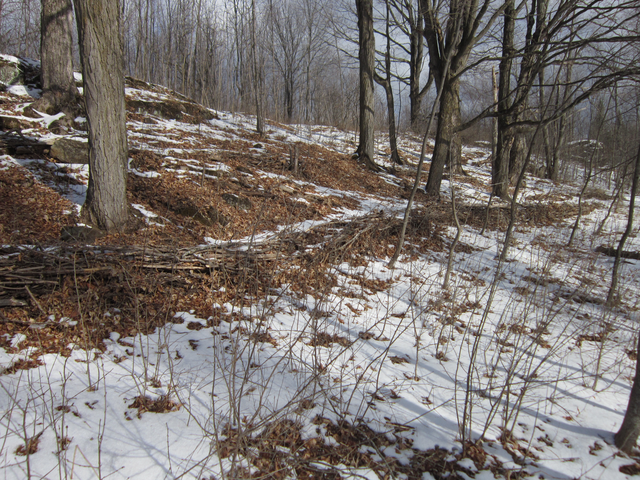
By Louis Laframboise
Reprinted from February 2019 Newsletter of the Ontario Society for Biodynamic Farming and Gardening
About nine years ago, I took part in the restoration of Graham Creek, which is located in the west end of Ottawa. The volunteers, including myself, were tasked with the job of building a fascine.(1) (One of the pronunciations of this word “fascine” sounds like and rhymes with the word “machine.”) We took a bundle of sticks and brush, including dogwood and willow, tied it all together with string at regular intervals and then secured the bundle along the stream bank using wooden stakes.
At that time, I saw a lot of potential for these make-shift but sturdy bundles. Rather than burning saplings and pruned branches or sending them to the compost pile where they take forever to decompose, or to noisy and smelly chippers, or to the landfill; they can be used on location in a wide range of applications. For example, they can be used to make discrete edges around garden plots or along paths and roadways.
I have used vines from both wild grape and Virginia creeper to hold fascines together. These collections of branches and brush look beautiful wrapped in the vines. The final product is flexible and more sturdy. They can be woven, as it were, onto and into the landscape so they end up looking a bit like long snakes.
The word “fascia” sounds somewhat similar to the word “fascine.” A fascia is a band of connective tissue under the skin in animals and humans. This tissue attaches, stabilises, encloses and separates muscles and other internal organs. The fascines work in a similar manner, stabilising the topsoil and delineating parts of the landscape. Just like bundles of fascia grouped together in the human body, fascines can be piled together or on top of each other, depending on the application.
The beauty of fascines is that they are multifunctional. They can hold a garden bed or mulch in place. They slow down or prevent erosion. They allow water to soak into the ground and prevent topsoil from travelling downhill. They also define edges, increase diversity, create micro-environments, and provide habitats for insects and wild animals. They feed the mycelia and sequester carbon. They can also be used in a check dam to slow water flow. There is no limit on how a fascine can be used.
On my small farm near Lanark, Ontario, I have used them to delineate paths and roadways, and I have placed them on contour to slow down water flow and catch organics. The more formal fascines can be moved around once they are made. These long sausage-shaped bundles are usually staked in place.
Winter is a good time to work on assembling fascines, especially if your time is preoccupied with living plants during the green part of the year. There are lots of variations and you do not need to follow rules on how to make them. Group bundles of old or newly-cut logs, branches and twigs together – even weave them together if you can – and then use where needed. Wrapping each bundle with vines is optional, as is placing them on contour. Eventually they will all break down and become soil and humus.
Fascines also have a special aesthetic appeal. Unlike metal fences and linear dividers, they provide a natural, flowing beauty and contribute to the integral sense of nature's harmony and perfection. Instead of being an environmental problem, they become an artistic solution.
Because of their transcendent qualities, I see fascines both as ecojewels of the landscape and also as catchers of ecojewels -- the silt, organic matter, soil, humus and water.
Louis Laframboise lives in the Lanark Highlands in eastern Ontario with his wife Laurie Clark and their young son Leif. Their 100-acre homestead is composed of fields, wetlands and forests interwoven with walking trails.
(1) “A fascine /fəˈsiːn/ is a rough bundle of brushwood or other material used for strengthening an earthen structure or making a path across uneven or wet terrain. Typical uses are protecting the banks of streams from erosion, covering marshy ground and so on.” “Fascine,” accessed February 11, 2019, https://en.wikipedia.org/wiki/Fascine.

Comentarios
neebee said:
Wow, thank you for the eye-opening (and now so obvious) introduction to this wonderful method. It is reminiscent of the low stone walls all over the Northeastern part of the United states, but more adept at remaining one with the land.
Andrew MacDonald said:
Love to see it when humans work with the land!
jrussey said:
GigiDear1 said:
Thank you for sharing this practice and including a photo.
This past winter I attended a lecture and walk at the local arboretum on lichens. I learned that lichens activate and process nitrogen in small amounts. Since then I take branches with lichens on them and place them around plants instead of placing them in the yard waste bin.
I do not understand how nitrogen carries / activates the astral but I do know that the practice works to encourage plant life. I have heard of and used 'hugelkultur' and now learn this lovely word 'fascines.'
Again, thank you!
Añadir nuevo comentario